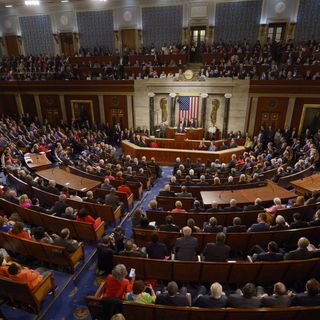The capital is eerily quiet – has been all week. No traffic, light activity on the streets, hill staff out in their districts working campaigns, lobbyists doing the same for members they want to win. There's gossip at restaurant tables across the city on who is up and who is down – and out. Quiet meetings in office suites going over rows of data in the swing congressional districts and Senate races, one eye on Fox and the other on MSNBC. Nothing and everything happening at the same time – that’s how it felt here this last weekend before the election.
1. The distilled wisdom of what will happen Tuesday has not been shaken...
The Senate will likely stay Republican, the House will likely go Democrat. After Kavanaugh, there was a clear momentum shift to the Republicans across the board, but especially in the Senate races for Democrats in super-Red Trump states where the president's populism and nationalism have the most resonance, and where he has campaigned repeatedly: North Dakota, Montana, Missouri, Indiana, Tennessee, West Virginia.
Democrats sensed a renewed determination of voters in metro and suburban areas to put a check on Trump...
In the House, where more than 40 Republicans have retired, principally in suburban seats – wealthier, more educated, more moderate – the surge narrowed the anticipated losses to the low 30s. The surge never threatened to stop Democrats from gaining the House. Then, when the parcel bombs went national and when 11 Jews were murdered in their synagogue in Pittsburgh, anxiety, fear, tension and unease over the country's direction emerged as the principal driver of sentiment. Democrats sensed a renewed determination of voters in metro and suburban areas to put a check on Trump, and to do it via their votes for local representatives to the House.
Aside from the die-hard Trumpists, even the most optimistic among seasoned Republicans puts the party’s House loss at no less than 32 – and it takes only 23 (of 435) to flip control. More objective political experts place the Democratic gain at no less than 35, and likely north of 40 – especially if turnout is more than 40 per cent (the normal midterm turnout is 38 per cent). Soundings across the country reveal profound unease of what is occurring across much of America – and who is responsible for it – but less so in those smaller regional states where Trump remains so popular. And this is the basis of the bifurcated result that so many are expecting.
2. What to look for as the House races come in
Watch the early returns that will start reporting by 11am AEDT Wednesday from New Jersey, Pennsylvania and Virginia. It is possible Democrats could get from those three states about half of the 23 seats needed to win control of the House. Whether they meet that mark will be an early sign of the size of the Democratic wave.
3. What to look for as the Senate races come in
The Democrats need a net gain of two seats to win the Senate. Democratic incumbents in North Dakota, Missouri, Indiana, Florida and New Jersey are all in danger. So out of that group, the Republicans should gain two seats. Republican seats in Arizona, Nevada, Tennessee and Texas are very tight – and Texas could be the shocker of the night if Ted Cruz falls to Beto O’Rourke. Out of this group, maybe the Democrats gain two. If the races play out this way: no net change in the Senate. But the odds are, given the higher number of vulnerable Democrats, for the Republicans to enjoy a slight net gain. That means Mitch McConnell can confirm more Trump Supreme Court nominees.
Explainer: Midterm election seats in play

4. The most interesting races for governor
Democrat Stacey Abrams in Georgia could become the first woman African-American governor in US history, and Andrew Gillum, also African-American, might win Florida. Barack Obama spent his last campaign weekend out for both. A Democrat may also succeed John Kasich as governor of Ohio – perhaps a sign of how Ohio might vote in 2020.
5. The big unanswered question in these last days before voting
Trump has pushed back hard on the airtime the media has devoted to the attacks in Pittsburgh and via the post. He blames it for stopping his post-Kavanaugh “momentum”. In response, Trump is carpet bombing the airwaves on immigration, the “caravan” of refugees coursing through Mexico – in some very ugly terms – and revoking birthright citizenship in the Constitution. His is a campaign of naked fear. Trump is using it because he believes it will do the job for him Tuesday. We will know one way or the other come Wednesday.
6. The shock outcomes that may yet occur
In 2016, it was "Trump elected president". In 2018, two shock headlines would be: Republicans keep control of the House and Democrats seize the House and Senate for the first time since 2006, isolating Trump’s power in Washington.
7. Memo to the Democrats
Yes, since Trump’s inauguration less than two years ago, his opponents have won the op-ed wars, the social media wars, the late-night-pundit wars, the comedy wars, the fact check wars, the ridicule wars, the irony wars, the apocalypse wars, the commencement address wars. Feels good, but they don’t get you borscht. The only war that counts is the ballot war.
8. Memo to the Republicans
If you lose the House, the question you need to ask yourselves is, “Why?” And the answer is “Donald J. Trump”. So, what are you going to do about it before he costs you the Senate and the White House? What do you as Republicans have to do to take your party back, and win in 2020?
9. This week’s cautionary tale
After 2016, who can responsibly make a prediction about an American election? Not the author of MidtermMatters. Two years ago, with highest confidence, your essayist blogger declaimed with authority: “Hillary Clinton to win with at least 274 electoral votes.” And atonement is still being made. Yes, I have no prediction. The most that can responsibly be said is: the only thing we will know Wednesday morning is whether the distilled wisdom in Washington this past week was right. As Brian Williams would say, see you on the other side.






